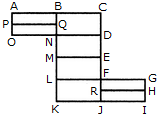Discussion
Home ‣ Non Verbal Reasoning ‣ Analytical Reasoning See What Others Are Saying!
- Question
Count the number of rectangles in the given figure.

Options- A. 8
- B. 17
- C. 18
- D. 20
- Correct Answer
- 18
ExplanationThe figure may be labelled as shown.
The simplest rectangles are ABQP, PQNO, BCDN, NDEM, MEFL, LFJK, FGHR and RHIJ i.e. 8 in number.
The rectangles composed of two components each are ABNO, BCEM, NDFL, MEJK and FGIJ i.e. 5 in number.
The rectangles composed of three components each are ACDO, BCFL, NDJK and LGIK i.e. 4 in number.
There is only one rectangle i.e. BCJK composed of four components.
Total number of rectangles in the figure = 8 + 5 + 4 + 1 = 18.
More questions
- 1. NAME
Options- A. .
- B. .
- C. .
- D. . Discuss
Correct Answer: .
Explanation:
Answer B
- 2. NA
Options- A. 1
- B. 2
- C. 3
- D. 4 Discuss
Correct Answer: 4
Explanation:
NA
- 3. NA
Options- A. 1
- B. 2
- C. 3
- D. 4 Discuss
Correct Answer: 1
Explanation:
NA
- 4. NA
Options- A. 1
- B. 2
- C. 3
- D. 4 Discuss
Correct Answer: 2
Explanation:
NA
- 5. NA
Options- A. 1
- B. 2
- C. 3
- D. 4 Discuss
Correct Answer: 4
Explanation:
NA
- 6. NA
Options- A. 1
- B. 2
- C. 3
- D. 4 Discuss
Correct Answer: 4
Explanation:
NA
- 7. NA
Options- A. 1
- B. 2
- C. 3
- D. 4 Discuss
Correct Answer: 2
Explanation:
NA
- 8. NA
Options- A. 1
- B. 2
- C. 3
- D. 4 Discuss
Correct Answer: 4
Explanation:
Option (d) is correct
- 9. NA
Options- A. 1
- B. 2
- C. 3
- D. 4 Discuss
Correct Answer: 4
Explanation:
NA
- 10. NA
Options- A. 1
- B. 2
- C. 3
- D. 4 Discuss
Correct Answer: 1
Explanation:
NA
Comments
There are no comments.
- 1.
Programming
Copyright ©CuriousTab. All rights reserved.
